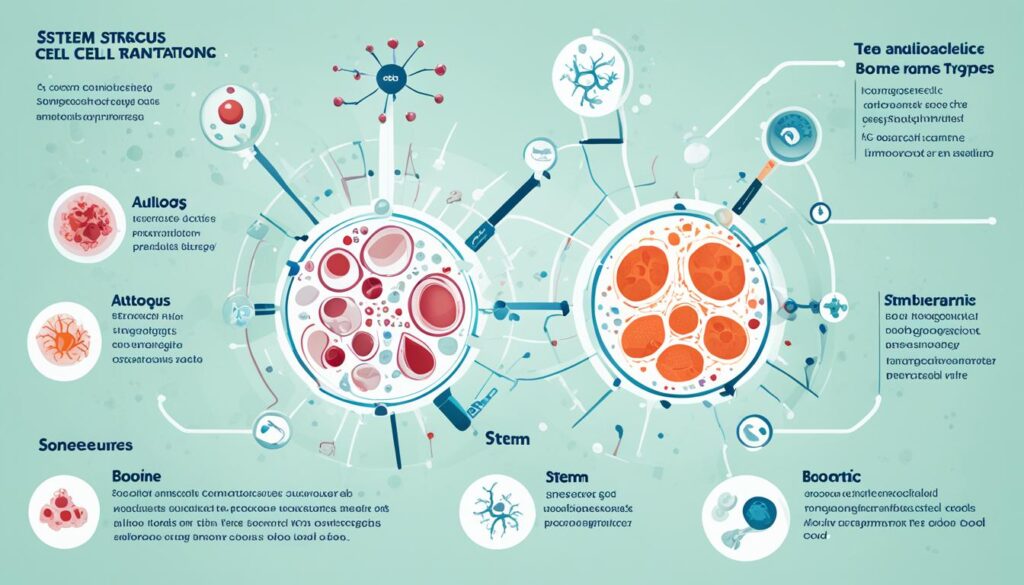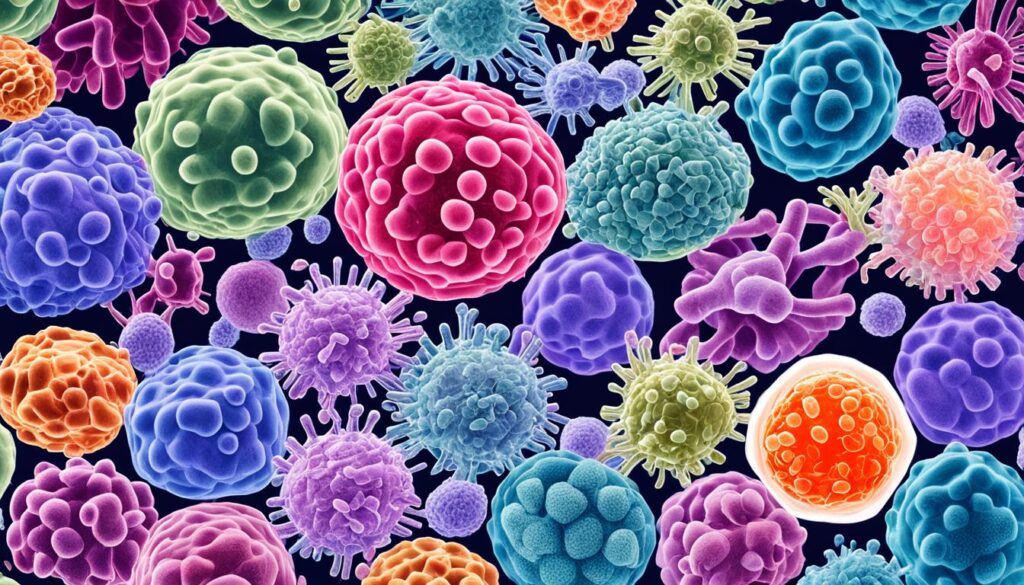Stem cells are the basic building blocks of our bodies. They can turn into different cell types. When cancer or treatments destroy these cells, stem cell transplantation (SCT) can help. This process, also known as a bone marrow or hematopoietic stem cell transplant, uses healthy stem cells to replace the damaged ones.
This advanced therapy is now a key treatment for some cancers. These include leukemia, lymphoma, multiple myeloma, and some solid tumors.
Key Takeaways
- Stem cell transplantation is a procedure that replaces damaged or destroyed stem cells with healthy ones.
- SCT can be used to treat various types of cancer, including leukemia, lymphoma, and multiple myeloma.
- Stem cells used in SCT can come from the patient’s own body (autologous) or from a donor (allogeneic).
- SCT offers hope for patients whose cancer or cancer treatments have damaged their stem cells.
- Advancements in SCT technology continue to improve outcomes and quality of life for patients.
Understanding Stem Cell Transplantation
Stem cell transplantation (SCT) is a key treatment for many blood and cancer conditions. It uses healthy stem cells to help the body make new blood cells after severe chemotherapy or radiation. There are different types of SCT, each suited for the patient’s needs and health history.
Types of Stem Cell Transplants
The main types of SCT are:
- Autologous transplantation, where the patient’s own stem cells are used. These stem cells are collected, treated, and then returned to the patient after high-dose conditioning therapy.
- Allogeneic transplantation, where stem cells are obtained from a donor, who can be a family member or an unrelated individual with a matching tissue type.
- Syngeneic transplantation, which utilizes stem cells from an identical twin.
There are also special types of SCT, like mini-transplants, which use lower doses of conditioning therapy, and tandem transplants, which involve two rounds of high-dose chemotherapy followed by stem cell infusions.
The choice of transplant type depends on many factors, including the patient’s cancer type, overall health, and donor availability. Your healthcare team will help pick the best SCT approach for you.

“Stem cell transplants work against cancer by restoring the body’s ability to produce new blood cells following high doses of chemotherapy and radiation therapy.”
When is Stem Cell Transplantation Recommended?
Stem cell transplants are a promising treatment for many medical conditions, especially in cancer care. They help patients with different cancers and blood disorders.
These transplants are often used for cancers that affect blood cells like leukemia, lymphoma, multiple myeloma, and myelodysplastic syndromes. They can also help with solid tumors, blood disorders like aplastic anemia and sickle cell disease, and autoimmune diseases. Researchers are looking into using stem cell transplants for other cancer types too.
Doctors decide if a stem cell transplant is right for a patient by looking at their health, cancer stage, and how well they’ve responded to past treatments. Those with high-risk or relapsed/refractory blood cancers might be good candidates.
| Condition | Stem Cell Transplant Recommendation |
|---|---|
| Acute Leukemia | Allogeneic stem cell transplant is indicated for refractory and resistant cases, especially for high-risk patients. |
| Multiple Myeloma | High-dose melphalan plus hematopoietic stem cell transplantation leads to increased overall survival and progression-free survival in patients under 65. |
| Myelofibrosis | Allogeneic stem cell transplant is recommended to improve outcomes. |
| Acquired Aplastic Anemia | Hematopoietic stem cell transplant produces superior outcomes compared to conventional immunosuppressive therapy. |
Stem cell transplants can be a ray of hope for many patients, but they also come with risks. It’s crucial to talk with a healthcare team to see if this treatment is right for you.

The Transplant Process
Getting a stem cell transplant is a big step that needs a lot of planning and watching. Before the transplant, the patient gets a “conditioning regimen” of high-dose chemotherapy, and sometimes radiation therapy. This treatment is hard on the body but is needed to make room for new stem cells.
To make giving the stem cells and drawing blood easier, a central venous catheter is put into the patient’s vein. After the stem cells are given, they go to the bone marrow. There, they start to divide and make new blood cells, a process called engraftment. Doctors keep a close eye on the patient’s blood counts to make sure the new stem cells are working well.
Conditioning Regimens
The conditioning treatment before a stem cell transplant usually takes a week or two. It can cause side effects like nausea, hair loss, and feeling very tired. This tough preparation is key to making room for the new stem cells to work and make more blood cells.
- High-dose chemotherapy is a main part of the conditioning, aiming to destroy the old bone marrow cells.
- Radiation therapy might be used in some cases to weaken the immune system more and make room for the new stem cells.
- The conditioning treatment plan is made just for each patient, based on their health history.
The transplant process is tough, but it gives hope to many patients with serious diseases. Knowing about the steps, from the conditioning to the new stem cells taking hold, helps patients prepare for what’s ahead.
Stem Cell Transplantation
Stem cell transplantation is a key treatment for many health issues, like leukemia, lymphoma, and autoimmune diseases. The stem cells can come from the patient themselves or from donors. Each source has its own benefits and things to consider.
Autologous transplants use the patient’s own healthy stem cells, saved for later use. This method is often used for treating lymphoma and multiple myeloma. Allogeneic transplants, on the other hand, use stem cells from a donor, usually a family member or a matched unrelated donor (MUD), for treating blood cancers like leukemia.
Haploidentical transplants use stem cells from a first-degree relative with a partial HLA match. This is seen as a safer option, making it quicker to find donors. Umbilical cord blood transplants are another choice, using stem cells from saved umbilical cords.
The success of a stem cell transplant relies on matching the donor’s and recipient’s HLA markers through HLA testing. This matching ensures the donor cells are seen as “self” by the recipient’s immune system. This reduces the risk of rejection and graft-versus-host disease (GVHD).
At times, the donor cells can have a “graft-versus-tumor” effect. This means they can target and destroy any cancer cells left in the body. This unique trait of allogeneic transplants can help make the treatment more effective.
| Stem Cell Source | Advantages | Considerations |
|---|---|---|
| Autologous | No risk of graft-versus-host disease, faster recovery | May not be suitable for cancer patients with extensive prior treatments |
| Allogeneic (Donor) | Graft-versus-tumor effect, suitable for blood cancers | Increased risk of graft-versus-host disease, need for HLA matching |
| Haploidentical | Increased donor availability, reduced wait times | Higher risk of graft-versus-host disease, more intensive treatment required |
| Umbilical Cord Blood | No need for HLA matching, readily available source | Limited cell count, slower engraftment, higher risk of infection |
Stem cell transplantation is a complex and evolving field, with ongoing research and advancements aimed at improving outcomes and expanding the range of treatable conditions. Understanding the different stem cell sources and their associated benefits and drawbacks is crucial in ensuring the best possible treatment for each patient.
Post-Transplant Recovery
Engraftment and Graft-vs-Host Disease
After getting stem cell infusion, it takes time for the new cells to settle in. Your blood counts will also take time to get back to normal. This process can take about 1-2 years. You might feel tired, have nausea, or get mouth sores during this time.
Long-term effects can include infertility, damage to organs, and secondary cancers. If you get stem cells from a donor, there’s a risk of graft-versus-host disease (GVHD). This happens when the donor cells attack your healthy tissues. Doctors use special drugs to help manage this issue.
| Metric | Autologous Transplant | Allogeneic Transplant |
|---|---|---|
| Recovery Time | Faster | Slower |
| Infection Risk | Lower | Higher |
| Graft-vs-Host Disease | Not Applicable | Higher Risk |
Be patient during the recovery process. With the right care and monitoring, you can get through the tough times and regain your strength.
“After a stem cell transplant, the recovery phase extends over a long period from discharge to 1 year or longer post-transplant.”
Managing Side Effects and Complications
Stem cell transplants can cause short-term and long-term side effects. These include nausea, fatigue, infections, and more. It’s important to eat well and work with your healthcare team to handle these issues.
The cost of stem cell transplantation can be high. It’s key to talk about insurance and money matters with your doctors. Luckily, there are many resources to help patients and caregivers with the transplant process.
Handling side effects and money issues is crucial for good results. Working with your medical team and using support resources can make a big difference. This way, you can focus on getting better.
 Gmrxe Entertainment and Information
Gmrxe Entertainment and Information




